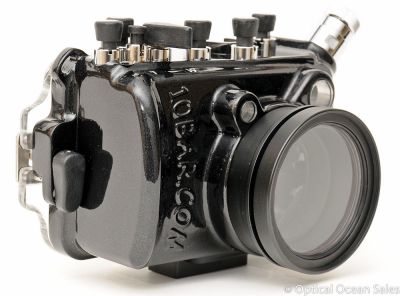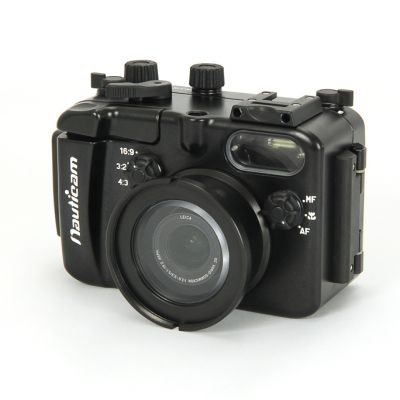Three Ways to Get Your LX5 Wet
Optical Ocean Sales has the new Ikelite, 10Bar housings and Nauticam housings in stock for the popular Panasonic high-quality LX-5 point and shoot camera. This camera has great features, with excellent control and a high-end lens and processor. It features a wide 24mm lens and leading edge video capabilities, in a small easy-to-use format. This article will review some of the differences between the housings available. All are rated to 200’. In the end it is up to each diver to find which best fits them.
The Ikelite housing is the largest physically, but that can be an advantage in cold water with gloves. The controls are standard Ikelite bent rods that you jiggle the switches with. With practice, they work pretty well, but they take some getting used to. The Ikelite housing is clear acyrlic, so you can see the entire camera. The knobs are large and are easy to use with gloves. It uses two non-standard screws to mount to a tray. It has built-in TTL with Ikelite strobes, which works well with all their DS strobes. It's hard to rig with optical sync strobes though. There is no method of mounting a focus light to it.
It's the most economical, at $549.95. The Ike housing relies on external wide angle lenses like their WP-20 - the problem is that the LX-5 has a 24mm lens and has to be zoomed in a fair bit to avoid vignette, thus negating the field of view with that lens. However, the new Nauticam wet mount wide-angle lens works fine, giving you back the 24mm that you have above water. It's small and light as well, but it doesn't really give you true wide angle.
With the Olympus PTWC-01 lens you can get a greatly increased 100+ degree field of view, although you do still need to zoom in. That lens is fairly heavy and large, not something you'd want to take on/off underwater.
Macro is no problem. The Ike housing (as do all it's competitors) has a 67mm threaded port to screw on an external diopter macro lens.
The 10Bar housing is redesigned from the their popular LX3 version and has the history of a year's run to work out any bugs. It is made from rugged aluminum, smaller, probably a little bit heavier in the water with a clear back. It's a step up in price at $709. Due to its design it is easier to grip than the Ikelite, but both will probably be used with a tray and handle. It uses a standard tripod mount screw. It has both hardwire and optical sync. It works great with a strobe like the Sea & Sea YS-01 or 110a, which have built-in optical D-TTL. The electrical sync bulkhead is a 5 pin nikonos style and supports legacy strobes like the Sea & Sea YS-90, or a Nikon SB-105, but only with the manual power settings on the back of the strobe. The controls are pretty good, dedicated, but you need a sense of feel with them. The knobs are small and close together, a problem if you are wearing gloves. All features of the camera are supported, including flash up and down. It uses a standard single mounting screw and fits most trays on the market.
Both the 10Bar and the Ikelite will have some issues with the LX-5's rear dial control. It can be pushed and turned and is quite tricky to make a control for. You can use other controls if necessary, or just use fine motions with it.
Probably the biggest advantage of the 10Bar is that it has several wide angle options, including the above "wet mount" 67mm lenses (with the same vignette issues); or unscrewing the port and using the Panasonic add-on wide angle lens with the 10Bar replacement wide angle port and dome (dry mount). The later can give one of the widest fields of view and can focus closely and sharply. These port replacements do not vignette and give very high quality results.
The Nauticam NA-LX5 has probably the finest build quality and design. Although more expensive at $950, it is aluminum and very well thought out, with excellent, ergonomic controls. It sits in your hand very nicely and controls are under your fingertips. All camera features are supported. The best feature is that they broke out the push and the turn function of the "joystick" rear dial on the camera into two distinct controls, making it positive and direct to use. This is much better than having one control that you try to turn without pushing. Buttons are fairly close together, as they are on the camera itself, but better than the other housings. Gloves can be problematic. There is a handstrap option for the right side, but it isn't big enough to fit a glove for cold water use. There is both a "coldshoe" mount and a threaded port for a ball mount on top of the housing to support a focus light.
The Nauticam housing is smaller as well. It does rely on external wide angle lenses, like the previously mentioned Nauticam wet mount replacement lens, or the Olympus PTWC-01 and Inon offerings. There are several tray options available for it, and it too uses two mounting screws.
Hopefully this article can help divers to compare the available housings. These are three excellent housings and only Optical Ocean Sales has all three in stock. Come on in so you can see them side-by-side and see what works best for you and your budget.
The Ikelite housing is the largest physically, but that can be an advantage in cold water with gloves. The controls are standard Ikelite bent rods that you jiggle the switches with. With practice, they work pretty well, but they take some getting used to. The Ikelite housing is clear acyrlic, so you can see the entire camera. The knobs are large and are easy to use with gloves. It uses two non-standard screws to mount to a tray. It has built-in TTL with Ikelite strobes, which works well with all their DS strobes. It's hard to rig with optical sync strobes though. There is no method of mounting a focus light to it.
It's the most economical, at $549.95. The Ike housing relies on external wide angle lenses like their WP-20 - the problem is that the LX-5 has a 24mm lens and has to be zoomed in a fair bit to avoid vignette, thus negating the field of view with that lens. However, the new Nauticam wet mount wide-angle lens works fine, giving you back the 24mm that you have above water. It's small and light as well, but it doesn't really give you true wide angle.
With the Olympus PTWC-01 lens you can get a greatly increased 100+ degree field of view, although you do still need to zoom in. That lens is fairly heavy and large, not something you'd want to take on/off underwater.
Macro is no problem. The Ike housing (as do all it's competitors) has a 67mm threaded port to screw on an external diopter macro lens.
The 10Bar housing is redesigned from the their popular LX3 version and has the history of a year's run to work out any bugs. It is made from rugged aluminum, smaller, probably a little bit heavier in the water with a clear back. It's a step up in price at $709. Due to its design it is easier to grip than the Ikelite, but both will probably be used with a tray and handle. It uses a standard tripod mount screw. It has both hardwire and optical sync. It works great with a strobe like the Sea & Sea YS-01 or 110a, which have built-in optical D-TTL. The electrical sync bulkhead is a 5 pin nikonos style and supports legacy strobes like the Sea & Sea YS-90, or a Nikon SB-105, but only with the manual power settings on the back of the strobe. The controls are pretty good, dedicated, but you need a sense of feel with them. The knobs are small and close together, a problem if you are wearing gloves. All features of the camera are supported, including flash up and down. It uses a standard single mounting screw and fits most trays on the market.
Both the 10Bar and the Ikelite will have some issues with the LX-5's rear dial control. It can be pushed and turned and is quite tricky to make a control for. You can use other controls if necessary, or just use fine motions with it.
Probably the biggest advantage of the 10Bar is that it has several wide angle options, including the above "wet mount" 67mm lenses (with the same vignette issues); or unscrewing the port and using the Panasonic add-on wide angle lens with the 10Bar replacement wide angle port and dome (dry mount). The later can give one of the widest fields of view and can focus closely and sharply. These port replacements do not vignette and give very high quality results.
The Nauticam NA-LX5 has probably the finest build quality and design. Although more expensive at $950, it is aluminum and very well thought out, with excellent, ergonomic controls. It sits in your hand very nicely and controls are under your fingertips. All camera features are supported. The best feature is that they broke out the push and the turn function of the "joystick" rear dial on the camera into two distinct controls, making it positive and direct to use. This is much better than having one control that you try to turn without pushing. Buttons are fairly close together, as they are on the camera itself, but better than the other housings. Gloves can be problematic. There is a handstrap option for the right side, but it isn't big enough to fit a glove for cold water use. There is both a "coldshoe" mount and a threaded port for a ball mount on top of the housing to support a focus light.
The Nauticam housing is smaller as well. It does rely on external wide angle lenses, like the previously mentioned Nauticam wet mount replacement lens, or the Olympus PTWC-01 and Inon offerings. There are several tray options available for it, and it too uses two mounting screws.
Hopefully this article can help divers to compare the available housings. These are three excellent housings and only Optical Ocean Sales has all three in stock. Come on in so you can see them side-by-side and see what works best for you and your budget.
















